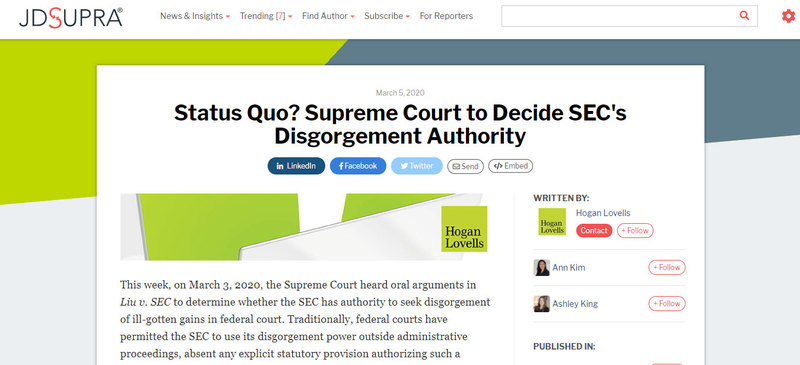Status Quo? Supreme Court to Decide SEC's Disgorgement Authority
This week, on March 3, 2020, the Supreme Court heard oral arguments in Liu v. SEC to determine whether the SEC has the authority to seek disgorgement of ill-gotten gains in federal court. Traditionally, federal courts have permitted the SEC to use its disgorgement power outside administrative proceedings, absent any explicit statutory provision authorizing such a remedy. The SEC has come to rely on disgorgement as a powerful enforcement tool. Indeed, in Fiscal Year 2019, parties in SEC enforcement actions were ordered to pay $3.248 billion in disgorgement of ill-gotten gains. Based on the remarks made by the Justices during oral arguments, it appears that the Court will most likely keep with custom and confirm that the SEC may seek disgorgement in civil proceedings as a form of equitable relief. At most, it seems like the Court may set a clearer standard on the calculation of disgorgement and the method of repayment of funds collected via disgorgement.
Background
This action stems from the SEC’s civil injunctive action filed in U.S. district court against petitioners Charles Liu and Xin Wang, in which the SEC alleged that the petitioners engaged in an EB-5 visa fraud scheme violating Section 17(a) of the Securities Act of 1933, Section 10(b) of the Securities Exchange Act of 1934 (“Exchange Act”), and Rule 10b-5 thereunder. The SEC alleged that the petitioners raised $27 million from Chinese investors looking to gain lawful permanent residence in the U.S. through the EB-5 Immigrant Investor Program. Rather than spend that money on building a cancer treatment center, which would have entitled the investors to receive EB-5 visas, petitioners spent $12.9 million for overseas marketing of the project, $8.2 million as personal profits paid to Liu and Wang, and only $4.5 million for property development of the center. The district court granted summary judgment to the SEC and ordered petitioners to pay disgorgement of $26.7 million constituting all funds received from the illegal conduct, plus prejudgment interest.
Oral Arguments
Petitioners want the Supreme Court to upend decades-long practice of granting disgorgement in SEC enforcement actions as “equitable relief” under Section 21(d)(5) of the Exchange Act. Based on the arguments heard this week, it looks unlikely that they will get their wish.
Justice Ruth Bader Ginsburg cut quickly to the point and stated, “Is it not an equitable principle that no one should be allowed to profit from his own wrong?" Justices Samuel Alito, Elena Kagan, Sonia Sotomayor, and Neil Gorsuch followed suit and indicated their belief that disgorgement was an equitable remedy. Justice Sotomayor noted that even though Congress had used the word “disgorgement” explicitly in other statutes and not here, there was nevertheless a historical practice of “something called disgorgement that could have been restitution . . . or unjust enrichment or something else of that ilk.” Justice Alito put petitioner’s arguments to the test when he asked, “Suppose [disgorgement] were limited to net profits and suppose every effort was made to return the money to the victims of the fraud. Would that not fall within a traditional form of equitable relief?” With the Court signaling its belief that disgorgement is an equitable remedy, the focus of the Justices crystallized on two main questions: 1) how should disgorgement be calculated, and 2) who should ultimately receive the funds collected from disgorgement.
Petitioners ultimately argued that disgorgement should be calculated by the gains to the individual defendants, not the value that the investors lost. Here, petitioners seem to argue that the appropriate amount Mr. Liu and Ms. Wang should pay is the $8.2 million in personal profits. However, petitioners never convincingly argued why they—or any wrongdoer—should be allowed to retain any of the remaining funding they received from investors in a “pervasively fraudulent scheme” where essentially all the expenses were made to perpetrate the fraud. The SEC, on the other hand, argued that disgorgement should be measured generally by net profits as well as the value of the expenses made to perpetrate the fraud. In this case, the SEC argued that almost the entire $27 million should be disgorged. The Court appeared to find the SEC’s argument more persuasive.
Regarding the identity and method of repayment, the Court seemed to come to an understanding that the SEC should make “good-faith efforts” to repay the harmed investors “where feasible” when distributing the funds collected via disgorgement. When not feasible, the Court appeared less inclined to direct the funds to the Treasury and seemed to prefer that the funds be returned to the SEC for the benefit of investors generally.
None of the Justices appeared ready to remove one of the SEC’s most powerful enforcement tools from their arsenal against violators. While good news for investors seems on the horizon, no decision is expected until June 2020.
https://www.jdsupra.com/legalnews/status-quo-supreme-court-to-decide-sec-46016/
Mentions
Litigation Cases
States
- California
Videos





Subscribe for News
Site Digest
Join Professionals on EB5Projects.com →
Securities Disclaimer
This website is for informational purposes only and does not constitute an offer or solicitation to sell shares or securities. Any such offer or solicitation will be made only by means of an investment's confidential Offering Memorandum and in accordance with the terms of all applicable securities and other laws. This website does not constitute or form part of, and should not be construed as, any offer for sale or subscription of, or any invitation to offer to buy or subscribe for, any securities, nor should it or any part of it form the basis of, or be relied on in any connection with, any contract or commitment whatsoever. EB5Projects.com LLC and its affiliates expressly disclaim any and all responsibility for any direct or consequential loss or damage of any kind whatsoever arising directly or indirectly from: (i) reliance on any information contained in the website, (ii) any error, omission or inaccuracy in any such information or (iii) any action resulting therefrom.



